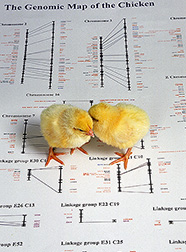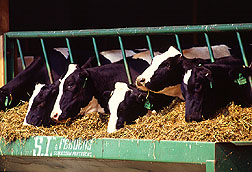|
Healthy Animals 27


Research
Briefs
The smell of success. Changing pigs’ diets could reduce odor-causing compounds in their manure.
Healthy snacks. A new eco-friendly barley variety provides farm animals with the essential nutrient phosphorus.
No-bull-ity. A new, genomics-based approach to identifying elite bulls could improve progeny testing methods.
Counting sheep nutrients. Investigating how lambs process selenium could help reduce selenium poisoning.

Awards
Animal physiologist Vernon G. Pursel and plant geneticist Wayne W. Hanna were among the three scientists named to the ARS Science Hall of Fame this year.
During the 38 years he worked for ARS, Pursel helped develop new reproductive biotechnology to accelerate the rate of genetic progress in farm animals, improving production efficiency.
Hanna, over 35 years, led a team in developing a series of forage grasses that have become the leading varieties used in summer pastures in the United States for more than 25 years.
Research leader Calvin L. Ferrell, of the ARS U.S. Meat Animals Research Center, received the Animal Growth and Development Award from the American Society of Animal Science. The award recognizes his research on metabolism and energy efficiency in ruminants, and on fetal growth and development in beef cattle. |
Health and Meat Animal Production
An ounce of prevention is worth a pound of cure—particularly when it comes to medicine.
This maxim is at the heart of many Agricultural Research Service (ARS) animal health programs, which aim to prevent illness whenever possible and treat it quickly when it does arise. In addition to the obvious disadvantages, caring for sick poultry and livestock can be expensive and time-consuming. Improving animal health ensures that U.S. producers can deliver a variety of safe, affordable animal products to national and international markets.
I Dream of Genomics
A house built on a solid foundation is better equipped to withstand the ravages of weather and time. Similarly, animals with a solid genetic inheritance are more likely to resist certain diseases. Genomics research at ARS labs throughout the United States addresses this issue by mapping animal genomes, identifying significant genes and providing tools to help guide producers' decisions.
At the Avian Disease and Oncology Laboratory (ADOL) in East Lansing, Mich., geneticist Hans Cheng and his colleagues created a genetic map for poultry that formed the foundation for genome assembly,  which in turn makes it easier to identify individual genes and determine their function. The information provided by the genetic map will enable Cheng and his colleagues to identify genes related to resistance to Marek's disease virus (MDV), an economically significant virus that promotes the growth of tumors in chickens. This information could be used to improve breeding programs and the development of vaccines for MDV and other serious poultry diseases. which in turn makes it easier to identify individual genes and determine their function. The information provided by the genetic map will enable Cheng and his colleagues to identify genes related to resistance to Marek's disease virus (MDV), an economically significant virus that promotes the growth of tumors in chickens. This information could be used to improve breeding programs and the development of vaccines for MDV and other serious poultry diseases.
Molecular virologist Stephen Spatz, of the Southeast Poultry Research Laboratory in Athens, Ga., and molecular biologist Robert Silva, of ADOL, initiated a comparative genomics program to investigate the differences in variants of MDV and identify predictors of virulence shifts. By examining the genetic differences between strains of MDV, the researchers hope to identify the genes that determine the pathogenesis of the virus. Identifying these genes will enable researchers to develop new, improved vaccines to protect chickens against currently circulating field strains, as well as those that may develop in the future.
In March 2000, researchers from the ARS Henry A. Wallace Beltsville (Md.) Agricultural Research Center (BARC) and the University of Vermont cloned a Jersey cow. She was genetically altered to secrete a naturally occurring, antimicrobial protein called lysostaphin into her milk, where it kills a major bacterial cause of mastitis. Even with existing treatments, mastitis costs the U.S. dairy industry about $1.7 billion every year. In tests conducted at BARC's Biotechnology and Germplasm Laboratory, three genetically engineered cows demonstrated significantly greater resistance to Staphylococcus aureus than a control group.
Another genomics study helped develop new tests to identify the bacteria that cause Johne's disease, an intestinal disease that afflicts cattle and other ruminants. Researchers at the National Animal Disease Center, in Ames, Iowa, and colleagues at the University of Minnesota sequenced the genome of Mycobacterium paratuberculosis, the disease's causative agent. Then they developed tests that can detect the microbe's presence in a fecal or milk sample within 72 hours, allowing producers to rapidly identify and isolate infected animals. In addition, researchers at both institutions are currently using the genome sequence to identify the best antigens to use in diagnostic assays.
Chill Out!
Stress in animals can foster poor health, reduced weight and, in the worst cases, death. Helping animals "keep their cool" can promote productive efficiency.
Three factors influence an animal's stress level: the environment, management practices and individual susceptibility. At the Roman L. Hruska U.S. Meat Animal Research Center (USMARC) in Clay Center, Neb., agricultural engineer Tami Brown-Brandl and her colleagues are developing a model for analyzing these influences and predicting an individual's stress level. The model also indicates a degree of certainty for each prediction, allowing producers to modify their responses accordingly.
Having the ability to identify animals with greater susceptibility to heat stress would allow producers to separate them and give them special care. The model could also monitor weather, helping them respond to environmental extremes. And producers could compare how different management strategies impact stress, enabling them to make the best decisions for the well-being of their herds.
In a separate study, Ted Elsasser, with the BARC Growth Biology Laboratory, is investigating whether vitamin E could be used to treat stress. Early studies suggest that preventative doses of vitamin E—which might be administered in anticipation of birth or weaning stress—may forestall the complications of oxidative stress, decrease susceptibility to infection and maintain growth rates in young cattle. If vitamin E proves to be an effective intervention treatment, this could translate into lower treatment costs, decreased antibiotic use and, ultimately, a healthier product for consumers.
Food, Glorious Food
Nutrition is another essential element of animal well-being. One way to ensure that animals eat a healthy diet is to have the highest quality forage available to them.  Dozens of research projects within the ARS Rangeland, Pasture and Forages National Program are designed to improve our nation's forage supply and teach producers how to use it most effectively. (See HA issue 26.) Dozens of research projects within the ARS Rangeland, Pasture and Forages National Program are designed to improve our nation's forage supply and teach producers how to use it most effectively. (See HA issue 26.)
In the ARS Livestock Issues Research Unit at Lubbock, Texas, research leader Jeff Carroll and his colleagues are testing nutritional supplements as alternatives to antibiotics for enhancing immune systems in swine and cattle. According to Carroll, some nutritional supplements, such as spray-dried plasma, could increase immunity in piglets by preventing pathogens from binding to their intestines. And fish oils help build immunity at a cellular level. This research has been expanded to include other nutritional supplements obtained from various yeast and plant sources.
A new program at USMARC and the Fort Keogh Livestock and Range Research Laboratory at Miles City, Mont., will aim at reducing cattle production costs by increasing feed efficiency. Currently, feed makes up 65-75 percent of beef production costs. The research will attempt to identify genes and other factors that influence efficient use of nutrients. Increasing efficiency will reduce costs and minimize the industry's environmental impact.
Click here to sign up for our free quarterly Healthy Animals newsletter! |
These are only a few of the current ARS research programs designed to promote animal welfare and improve production. Together, they help ensure that the United States maintains one of the strongest animal production industries in the world.
For more information about ARS's Food Animal Production National Program, contact Ronald D. Green.
|